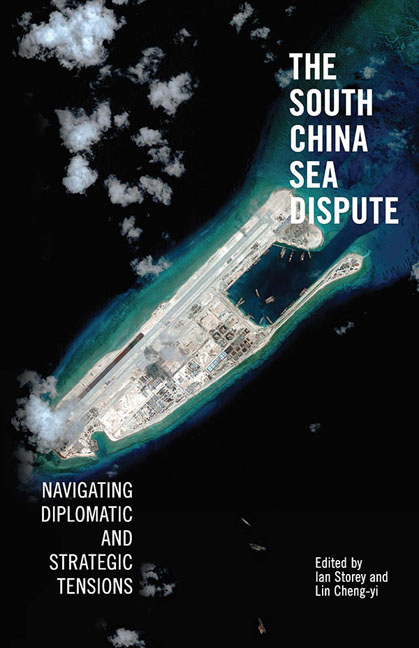Book contents
- Frontmatter
- Contents
- About the Contributors
- 1 Introduction
- 2 Untangling a Complex Web: Understanding Competing Maritime Claims in the South China Sea
- 3 China Debates the South China Sea Dispute
- 4 Taiwan's Evolving Policy towards the South China Sea Dispute, 1992–2016
- 5 The South China Sea: Primary Contradictions in China–Southeast Asia Relations
- 6 Rising Tensions in the South China Sea: Southeast Asian Responses
- 7 The Philippines and the South China Sea Dispute: Security Interests and Perspectives
- 8 A Vietnamese Perspective on the South China Sea Dispute
- 9 The South China Sea Dispute: Options for Malaysia
- 10 The United States and the South China Sea: Front Line of 228 Hegemonic Tension?
- 11 The South China Sea Dispute in U.S.–ASEAN Relations
- 12 Japan and the South China Sea Dispute: A Stakeholder's Perspective
- 13 Conclusion
- Index
4 - Taiwan's Evolving Policy towards the South China Sea Dispute, 1992–2016
Published online by Cambridge University Press: 19 May 2017
- Frontmatter
- Contents
- About the Contributors
- 1 Introduction
- 2 Untangling a Complex Web: Understanding Competing Maritime Claims in the South China Sea
- 3 China Debates the South China Sea Dispute
- 4 Taiwan's Evolving Policy towards the South China Sea Dispute, 1992–2016
- 5 The South China Sea: Primary Contradictions in China–Southeast Asia Relations
- 6 Rising Tensions in the South China Sea: Southeast Asian Responses
- 7 The Philippines and the South China Sea Dispute: Security Interests and Perspectives
- 8 A Vietnamese Perspective on the South China Sea Dispute
- 9 The South China Sea Dispute: Options for Malaysia
- 10 The United States and the South China Sea: Front Line of 228 Hegemonic Tension?
- 11 The South China Sea Dispute in U.S.–ASEAN Relations
- 12 Japan and the South China Sea Dispute: A Stakeholder's Perspective
- 13 Conclusion
- Index
Summary
The Republic of China (ROC) or Taiwan was the first country to claim sovereignty over the Pratas Islands (Tungsha Islands), Macclesfield Bank (Chungsha Islands), the Paracel Islands (Shisha Islands) and the Spratly Islands (Nansha Islands) in the South China Sea after Japan's withdrawal from the islands at the end of the Second World War. In November 1946, the ROC government moved to “restore” the South China Sea atolls to Chinese sovereignty. On 1 December 1947, the ROC Ministry of the Interior renamed those islands and formally transferred their administration from Guangdong Province to the Hainan Special Region. In 1948, the ROC government published an official map which showed the four archipelagos within the so-called “U-shaped” line. The ROC's control over the Paracel and Spratly Islands was challenged by France and the Philippines in 1947 and 1949, and was disrupted between May 1950 and July 1956 due to the Nationalist government's (Kuomintang or KMT) defeat in the Chinese Civil War. However, the KMT re-established a garrison on Itu Aba (Taiping Island) in July 1956 and the ROC on Taiwan has controlled the island ever since. Apart from Itu Aba, Taiwan also controls Ban Than Reef (Zhongzhou Reef), approximately 5 km from Itu Aba as well as the Pratas Islands (Tungsha Islands).
Despite being a claimant in the South China Sea, Taiwan's position as a party to the territorial dispute has been undermined due to Southeast Asian countries adherence to Beijing's “One China” policy. It has even been argued that Taiwan — which is not recognized as a sovereign state by the majority of countries — “has no juridical standing to make any claims to any territory”.Inevitably, the “China factor” plays a role in Taiwan's policy considerations towards the South China Sea dispute. When cross-straits relations are cordial, Taiwan and mainland China (the People's Republic of China, PRC) tend to develop a shared dedication to promoting territorial claims on behalf of “China”. When relations deteriorate, however, cross-straits coordination over the South China Sea breaks down and Taiwan tends to become more concerned about the security threat posed by the PRC and therefore adopts a more conciliatory policy towards the Southeast Asian claimants in order to balance Beijing.
- Type
- Chapter
- Information
- The South China Sea DisputeNavigating Diplomatic and Strategic Tensions, pp. 74 - 103Publisher: ISEAS–Yusof Ishak InstitutePrint publication year: 2016



